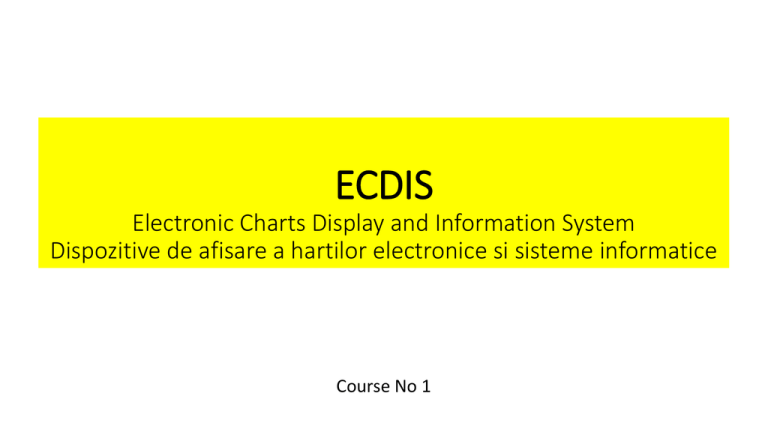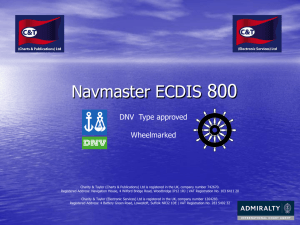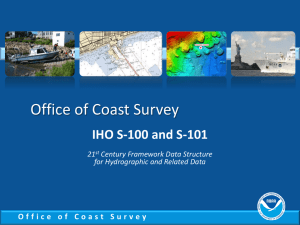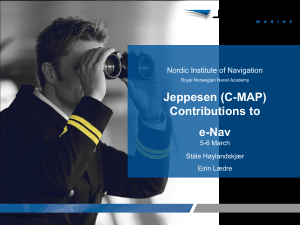ECDIS Electronic Charts Display and Information System
advertisement

ECDIS Electronic Charts Display and Information System Dispozitive de afisare a hartilor electronice si sisteme informatice Course No 1 ECDIS? 1) What does ECDIS mean (purpose)? 2) What do you know about this subject (connections, use, functions)? 3) What type of ECDIS did you use? Describe the used functions. 4) ECDIS – Limitations; Difficulties. 5) How do you think that ECDIS course will help you? ECDIS aims • ECDIS training does not teach the student how to navigate – that level of knowledge is taught and practiced elsewhere. • What you are really learning to do is how to use the ECDIS system to navigate safely. Content of the discipline On successful completion of the training the students will be familiar with the watchkeeping duties of a deck officer regarding the ECDIS equipment. Knowledge and understanding of ECDIS in navigation Proficiency in operation, interpretation, and analysis of information obtained from ECDIS Maintain the safety of navigation using ECDIS La finalizarea cu succes a perioadei de instruire, studentii vor fi familiari cu indatoririle de cart ale ofiterului de punte in ceea ce priveste utilizarea echipamentului ECDIS. Cunoaşterea rolului echipamentului ECDIS in cadrul sistemului de navigatie Competenta in operarea, interpretarea si analizarea informatiilor obtinute de la ECDIS 1 Elements of ECDIS 1. Introducere in utilizarea ECDIS - Describes principal types of Electronic Chart System - Descrierea principalelor tipuri Sisteme de Harti Electronice - Describes the differences between Vector and Raster Charts - Describes the terms and definitions used in the context of ECDIS - Explains the major characteristics of ECDIS data such as: data term and definition; data contents; data structure; attribute; data quality and it accuracy - Describes the position reference system Mentinerea sigurantei navigatiei cu ajutorul echipamentului ECDIS - Descrierea diferentei dintre hartile vectoriale si hartile raster - Descrierea termenilor si definitiilor in contextul ECDIS - Explicarea caracteristicilor majore ale ECDIS: continutul si structura datelor, precizia si acuratetea acestora - Descrierea sistemului de referinta a pozitiei 2 Watchstanding with ECDIS 2. Rolul ECDIS in conducerea navei - Explains the scope and selection of chart data display categories - Explains the safety value available in ECDIS - Describes the automatic and manual functions of ECDIS - Explains various sensors, its accuracy requirement and state proper action to take in case malfunction - Describes the production and distribution of updatesmanual, semi-automatic and automatic updating - Explicarea scopului si a modalitatii de selectare a categoriilor de harti (in functie de informatiile afisate) - Explicarea “Safety value” - Descrierea functiilor „automat” si „manual” ale ECDIS - Explicarea diferitor senzori, cerintelor privind acuratetea acestora si a actiunilor in caz de functionare defectuoasa - Descrierea elaborarii si distribuirii de update-uri manuale, updata-re automata si semi-automata 3 ECDIS Route Planning 3. Planificarea rutei utilizand echipamentul ECDIS - Describes the route planning and route monitoring in ECDIS - Describes the route planning information; route planning calculation; calculation the voyage schedule; construction of a route; planned route checking for navigator safety; alternative route; optimization of route planning and ultimate route selection - Descrierea planificarii si monitorizarii rutei de navigatie cu ajutorul ECDIS - Descrierea informatiilor pentru planificarea rutei, a calculelor implicate de planificare; planificarea in timp a voiajului dpdv al rutei, constructia rutei; verificarea dpdv al sigurantei navigatiei a rutei planificate; rute alternative; optimizarea planificarii rutei si selectarea rutei 4 ECDIS Charts, Targets & System 4. ECDIS – harti, tinte, sisteme - ARPA, AIS functions - Demonstrates the uses of all specific functions and obtain all relevant information for route planning and monitoring for navigating and for the ship’s safety: - Interconectarea cu ARPA si AIS - Demonstrarea utilizarii functiilor specifice si obtinerea informatiilor relevante pentru planificarea si monitorizarea rutei, pentru navigatie si pentru securitatea navei: - sea area selection, - route planning information, - construction of a route, - adjustment of a planned route, - curve track planning, - planning notes, - check for navigational safety, - Ultimate route, monitored area-- vector time, check measurements, alarms, - current and wind. - selectarea zonei de navigatie - informatiile de planificare a rutei - construirea rutei - ajustarea unei rute planificate - planificarea zonelor de giratie - limite de siguranta - verificari pentru siguranta navigatiei - ruta finala, zona monitorizata, scara vectorilor, verificarea masuratorilor, alarme - probleme de vant si curent. 5 ECDIS Responsibility 5. Responsabilitati in utilizarea ECDIS - Explains the meaning of Status Indications, Indicators and Alarm relating to ECDIS - Explains the typical errors of interpretation and take proper action to avoid these errors - Describes the possible risk of over-reliance and complacency on ECDIS. - Explicarea intelesului „Status indications”, Indicatori si alarme ale ECDIS - Explicati erorile tipice de interpretare si actiunile corespunzatoare pentru evitarea acestora - Descrierea riscurilor posibile ale supra-increderii si „complacency” in ECDIS History of ECDIS? The SOLAS 1974, subsequently amended in 2000 and 2002, specifies the requirements for the navigational equipment to be used on board ocean-going ships. • Adopted by IMO – the right agency for creating an internationally recognized definition of an electronic chart. • Names used before for this type of equipment: “Electronic Sea Chart” and “Electronic Chart Display System” • Including the term “Information” refers to the broader capabilities to manipulate and display ECDIS information, which extend far beyond that of pictorial representation of charts on a computer screen. The work on formulation the performance standard for ECDIS started in 1986 and continued until 1995 when the “Performance Standards for ECDIS” were formally adopted. In 2008 the IMO accepted recommendations to make ECDIS compulsory, 2010 STCW "Manila Amendments" Chapter II Operational and Management Level - Electronic Chart Display and Information System (ECDIS) will be required training for all deck officers on all vessels that are equipped with ECDIS. ECDIS will be treated the same as ARPA or the GMDSS training. The amendments to SOLAS Chapter V Regulation 19 – Carriage Requirements for Shipborne Navigational Systems and Equipment came into effect on 1 January 2011. • The amendments to the SOLAS Convention now clearly include ECDIS systems within the definition of nautical charts and publications with section 2.4 stating that “An Electronic Chart Display and Information System (ECDIS) is also accepted as meeting the chart carriage requirements of this subparagraph”. ECDIS system implementation schedule ECDIS performance standards (1) An area which often leads to confusion is the simple question of what makes one system an ECDIS and the other an ECS (Electronic Chart System). The answer to this question is simply that one system complies fully with the IMO ECDIS performance standards and can be accepted as meeting the requirements of SOLAS Chapter V regulation 19 and the other does not. These requirements are identified as follows: The ECDIS equipment must be type approved to the performance standards as outlined in IMO Resolution A. 817 (19) as amended by MSC 64(67) & MSC 86(70) relating to back up arrangements for ECDIS systems and operation in RCDS mode. ECDIS performance standards (2) The system must use official ENC data (Vectorised Electronic Navigational Charts) to IHO S-57 standard, which must be supplied by or authorized by a National Hydrographic Office. Such ENC data must be corrected weekly. The vessel must have an adequate back-up system. This may be another ECDIS system or paper charts. IMO has ruled that ECDIS equipment having Raster Chart Display System (RCDS) capability may operate as a primary aid to navigation in the RCDS mode. Such charts must also be corrected on a weekly basis. When ECDIS equipment is used in RCDS mode, it must be used in conjunction with an appropriate folio of paper charts. The definition of ‘appropriate’ is to be decided by national administrations. S-57 • S-57 is a set of regulations approved by IMO and IHO (the international organizations responsible for the safety at sea requirements and related cartography) for standardization of cartographic data exchange between Hydrographic Offices, Regional Chart Distribution and ECDIS - producers. • S-57 chart comprises data of two sort - spatial (location information about real world entities) and feature (descriptive information about real world entities). Data in S-57 data set (chart) is organized in objects. Spatial objects (e.g. node, edge, face) possesses coordinates which define its location on the Earth's surface. Feature object (e.g. BOYCAR - buoy cardinal, COALNE - coast line, LNDARE - land area) contains attributes - qualitative or quantitative characteristics of the object. Object may reference each other that enables simulation of arbitrary level of complexity. Detailed information on S-57 may be found in: S – 57 Standard ECDIS acronyms • ECDIS Electronic Chart Display and Information System • ECS Electronic Chart System • ENC Electronic Navigational Chart • RNC Raster Navigational Chart • RCDS Raster Chart Display System • IBS Integrated Bridge System • NACOS Navigation and Control System “Generic ECDIS course” and “Type Specific ECDIS training” There are some confusions on the part of both deck officers and companies regarding the requirements for Electronic Chart Display and Information System (ECDIS) training. There are two elements that must be satisfied for ECDIS training and STCW certification. The first element is to satisfy the international requirements by completing a “Generic” ECDIS course. This allows a deck officer to have training in accordance with the STCW Code authorizing service on ECDIS equipped vessels. The second element required by the STCW, is for all deck officers to have received ship specific ECDIS training, in order to safely operate the ECDIS equipment installed on board, this training is often referred to as “Type Specific” ECDIS training. Training schools are not allowed to mix the STCW certification training for generic ECDIS and type specific ECDIS training together into one course. The two training elements must be conducted separately. In most cases the prerequisite for attending type specific ECDIS familiarization training is to have already successfully completed an approved generic ECDIS course. Approved “Generic” ECDIS Training Courses • All “Generic” ECDIS courses should be based on the IMO Model Course 1.27, ECDIS (2010 Edition). Paper charts – their deficiencies (1) • A very poor interface to electronic positioning systems • High latency • „High‟ probability of plotting errors • Difficulty of route planning on multiple charts • Complicated navigation at chart boundaries • Updating process (corrections) is time consuming and error prone • Large size makes optimal siting of chart table difficult • Sub-optimal siting and high work load takes navigators attention away from bridge windows and other situational awareness displays • Confined to North-up operation • Expensive delivery with high latency (measured in many days ...) ECDIS is not a paper chart on an electronic display • It has quite different strengths and weaknesses compared to the use of paper charts • The visual experience is surprisingly different – and so is their actual use • Using either must be based on taking advantages of their particular strengths and compensating for their weaknesses • A working knowledge that exploits the benefits but minimizes the weaknesses is the basis of a good mindset The ECDIS mindset • Building a new mindset for ECDIS is essential – it is not a minor modification of a paper chart mindset • ECDIS has much greater functionality and therefore greater inherent usefulness than a paper chart • The why and how of its functionality need to be part of the new mindset • Unfortunately, the assimilation of good ECDIS practice is unlikely to be fully obtained in a course of just 5 days (or less!) (In comparison, how long does it take to be totally familiar with paper chart navigation?) Why is an ECDIS mindset different? • Data on a paper chart is always visible but fixed in detail • Data shown on ECDIS has user selectable detail but requires knowledgeable settings • Data on a paper chart has been skilfully laid out by a cartographer • A clear electronic chart presentation relies heavily on the skills of the user • Users must compensate for the relatively small size of an ECDIS display • Users must compensate when working close to the edges of a paper chart Why is an ECDIS mindset different? • ECDIS can give a false sense of positional accuracy, which is seldom the case when using a paper chart. • Accurate position plotting on paper is difficult and tedious. Errors of position fixing equipment may be masked. • The understanding of ECDIS alarms and their management is essential. • ECDIS is electronic and can fail at any time in a number of ways, some subtle. Describes principal types of Electronic Chart System ECDIS RCDS ECS Technical requirements • To be considered equivalent with, or indeed superior to paper charts, such system must fulfil considerable technical requirements: The chart data in use must be officially authorized; The graphic display on the screen must met the equipment-independent specification; The equipment must support the full range of navigational functions that can be performed on the traditional paper charts What defines the data and ECDIS? • To be considered “official”, chart data must meet two requirements: - authorized by a national government agency, the national Hydrographic Office - it meet the specifications of the IHO The chart data can be authorized only by the national authorities that are responsible for creating, collecting and preparation of such information, that is, by the national Hydrographic Services. It may be noted that this not imply that official data must be also produced by an HO. Production can be contracted out, or delegated to, a private company, provided the Hydrographic Office authorizes the use of the official data. • The IHO has defined a uniform data exchange format: “Transfer standard Hydrographic Data- IHO S-57”, containing the ENC product specification. • The obligatory uniform way of presenting the data on the screen is specified in another IHO standard, the “Colors and Symbols Specifications for ECDIS, IHO S-52,1996”, in its appendix 2, called ECDIS Presentation Library. • To be called ECDIS, the equipment that is to be installed on board must do much more than just properly display the stored chart data. It must support the whole range of navigational functions that make use of the characteristics of the chart data and their specific presentation. For this reason, the IMO has developed a standard describing the minimum of functional requirements of an ECDIS – IMO performance standard, 1995 (Ch 4 and 13). • To ensure that ECDIS equipment intended for on board use is seaworthy, it must pass type approval and test procedures developed by the International Electrotechnical Commission (IEC) and based on the IMO and IHO requirements. (explanation of the type approval process for ECDIS – Ch13) Co-operation of the international organizations • An overview of co-operation of the three above-mentioned organizations and the description of the standards developed by them. ECDIS - an information system • To claim the title of information system, ECDIS must offer, besides the graphic presentation of the chart, additional information about the characteristics of the displayed features. Within the ECDIS the ENC database stores the chart information as lines, areas or geographic objects. • Appropriate mechanisms are built into the system to query the data, and then to use the obtained information to perform certain navigational functions (eg. Anti-grounding surveillance)- Ch7 ENC • The electronic navigation chart (ENC) means a database, standardized as to content, structure and format, issued for use with ECDIS • The ENC contains all the chart information necessary for the safe of navigation and may contain supplementary information in addition to that contained in the paper chart(eg sailing directions), which may be considered necessary for the safe of navigation.






